Abstract
A big part of traditional architecture both in rural and urban areas in the Greek territory has been built with raw earth. The aim of this paper is to present earthen buildings’ constructions in Greece and show their important contribution to our heritage. The use of earth as a basic constructing material has given different earthen building cultures and techniques. Earthen construction encloses many varied uses and applications, as walls or as plasters. In different periods of time and historical contexts, from the indigenous inhabitants to the neighborhoods of the refugees of Asia Minor Catastrophe, the earth constructions had a primary role. The existence of earthen architecture was investigated in urban and rural sites in Greece. Building information, documentation, and records of buildings’ design, construction techniques, elements, and systems are presented. Today, there is still a rich architectural heritage throughout the country, which has lasted through the years and withstood seismic activities and poor conservation.
1. Introduction
The use of earth as a building material has had a dynamic presence and development in Greece throughout time. Since the earliest ancient Greek civilizations, it has had a central role in the organization of building technology; in combination with other natural materials like wood (more or less processed), straw, cane, and lime, various building techniques emerged and developed. A key factor that shaped the traditional construction methods using earth has been the contacts of Greeks with other neighboring civilizations, namely, those of Northern Africa, the Middle East, and Asia Minor where, as is known, extensive use of earth was made even in large-scale projects. Since the second half of the 20th century, however, the use of earth as a main building material declined: it lost its importance, was ignored, and eventually forgotten. In recent years, contemporary environmental issues have contributed to the re-evaluation of this material and its particular features. The earthen constructions have reappeared during the past ten years in contemporary architecture.
Many books give historical, architectural, and cultural information about the traditional architecture of Greece. For instance, Melissa editions [1] published an architectural series in order to give a complete picture of each area, presenting photographic and research material, but the earthen constructions are not presented in depth or are completely ignored. Additionally, a study of thirty buildings constructed by Macedonian master builders during the 18th and the 19th century, at a period when this area formed part of the Ottoman Empire, has already been conducted, but little is presented about the rest of the sites of Macedonia [2].
2. Materials and Methods
2.1. Project’s Scope
In the last decades, there has been an increasing interest in the architectural heritage of Greece. The earthen constructions have not been studied yet, and in many areas, these buildings techniques are ignored or forgotten. This paper presents the results of in situ research for earthen constructions in areas where it is assumed that earth was used as a building material. The aim of this paper is to present the existing architecture in discovered areas where clay was used as a material. Additionally, this research was conducted in order to evaluate the existing architecture, identify the quantity of diverse earthen structures, and record them according to site condition, construction technique, and quality. The novelty of this documentation has two different aspects. Firstly, the design of a record system for this project’s specific needs, and secondly, the analysis of an unknown architectural heritage. Buildings with earth in Greece are an important cultural resource for the country, and this project’s goal is to find ways for its protection and restoration; this means the training of scientific and technical staff and strengthening of local economies with sustainable environmental architecture. The study was conducted in 2018 and 2019 in the mainland and islands of Greece, Figure 1.
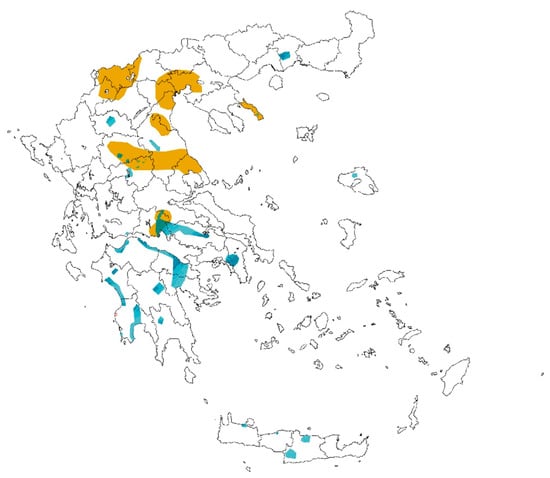
Figure 1.
Visited territories with earthen architecture in Greece. Blue color area: where raw earth’s construction techniques have been recorded by authors. Brown color area: with raw earth’s construction techniques according to G. Bei, Terra Europae, Earthen Architecture in the European Union, 2011.
Additionally, this study attempts to evaluate the earthen architecture in Greece, show the developed style of construction, investigate the building typologies, and correlate them with the prevailing social and cultural systems.
2.2. The Method of the Research
The documentation is the evidence provided for existing earthen constructions, Figure 1. The evidence includes primary sources, provided raw information (first-hand evidence), statistical data, secondary source interviews, and data collected in situ. A primary source for this study was given by direct access to the subject allocated in many scheduled visits to the Greek territory over two years. The architecture, the condition of the constructions, and construction techniques were recorded with photographic documentation. The earthen buildings have been discovered and defined based on historical data, observations on the built environment, and the area characteristics, in order to have the ability to provide raw materials for earthen construction. The existing earth architectural heritage in Greece mainly refers to the periods of the Ottoman and Modern Greek state. The often violent transition from one state entity to the other is also reflected in architecture with the gradual transition from the recent (14th–19th century) traditional architecture to neoclassicism. Earth as a building material is present in both phases. This research is presented in relation to the historical evolution of the Greek state. The documentation can provide a knowledge tool for earthen architecture and also highlight the earthen architecture of Greece as part of our cultural heritage. This study will provide an archive that will help to create a legal framework for conservation actions.
2.3. Taxonomic Study
A systematic and in-depth study started in 2018 for the documentation of raw-earth-based constructions all over Greece. This study is structured in four stages: collecting, organizing/defining, processing/classifying, and utilizing the collected material. Due to the lack of bibliography and any other systematic documentation material, the effort of this research is in-situ recording. For practical reasons, there has been a division into five main study areas: Peloponnese, Central Greece, Northern Greece, Macedonia, and Islands. In more detail, the records from in-situ observation have been organized in:
The inventory recording tables are the main mapping tool for existing earthen constructions. The places visited are chosen based on readings, physical and historical maps, as well as on experience-based criteria. This approach is based on projects carried out elsewhere in Europe, such as clay buildings in Abruzzo, Italy [3,4], which have been taken into account. In order to cover the needs of this project, an analogue and digital template was created for the documentation of each building. They are being filled in with data collected in situ and from other available sources. Up to now, approximately 1000 such tables have been filled. In more detail, the tables include data related to geolocation on a map, building coordinates, building techniques, preservation notes, building condition at the moment of documentation, and technical-construction characteristics (see Figure 2).
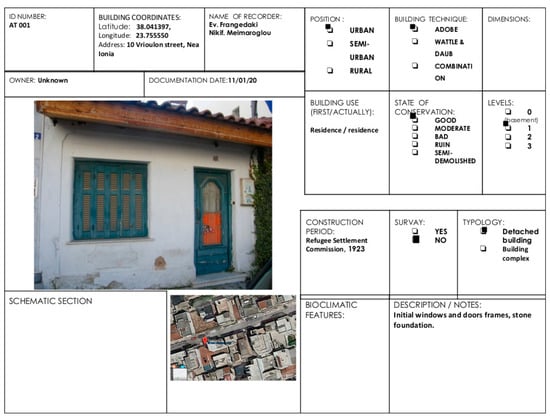
Figure 2.
Sample of recording tables for buildings in the Municipality of Nea Ionia in Athens.
The interviews are an important documentation material and a source of information regarding the building process, the local terminology, the traditional construction techniques, etc. Bibliography and other printed references: In addition to the basic bibliography, a number of other documents are used for this research. These can be notaries’ deeds, historical texts, technical reports following earthquakes, technical manuals and regulations, photographs, and other documents from historical archives, municipality archives and government agencies [5].
Undergraduate and postgraduate student projects and doctoral theses: These include projects in undergraduate laboratories, undergraduate diploma projects, and undergraduate research, as well as graduate work in postgraduate programs in Restoration of Monuments and Sites at the NTUA, the AUTH, and the TUC (see Figure 3).
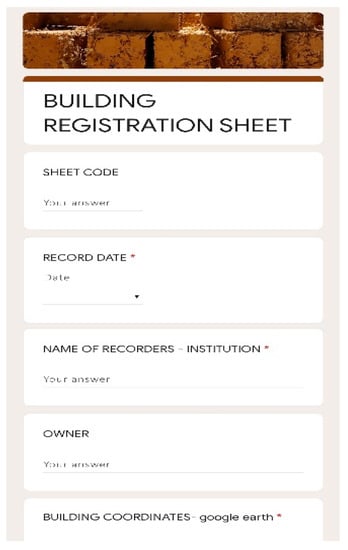
Figure 3.
Inventory table template available for mobile devices (Piliko archive, edited by D. Kada).
3. Historical Background
3.1. Building with Earth in the Ancient Greek Territory
From excavations and other archaeological research, we know that earth has been used as a main building material along with other natural materials since the foundation of the first prehistoric settlements. Typical examples are the settlements of Sesklo, Dimini [6], and Dispilio. The first structures consisted of a mixture of branches and earth that later evolved into structures of adobe bricks and mixed structures with wooden elements or reeds and earth fillings. The transition to earth plinth signified an important cultural development that had a major influence on the architecture and the shaping of the residential complexes.
As early as the Minoan era (2600–1100 B.C.) there is evidence of the use of adobe bricks and other earth building materials in complex palace complexes such as Zakros, Malia (Figure 4), and Knossos. In the Minoan town of Gournia, most of the houses were high-rise and built over a height with adobe, while their flat roofs were formed with pressed earth [7]. The documented contact of this civilization with Egypt and the Middle East, where the use of earth in Architecture played a major role, lets us assume that building expertise was transferred from there to Crete.

Figure 4.
Archaeological site of Malia: (a) building foundations; (b) Wall made of adobe bricks coated with earth mortar (photos by A. Mousourakis).
In the early historical times (1100–700 B.C.), rectangular buildings, but also some more plastic–organic in shape, are constructed, apart from the stone foundation, with either adobe brick or earth-coated canes [8]. A typical example of a large arched building is that of Tuba, in Lefkandi, Euboea (Figure 5) of the 10th century B.C., made of adobe on a stone base 1 m high [8].
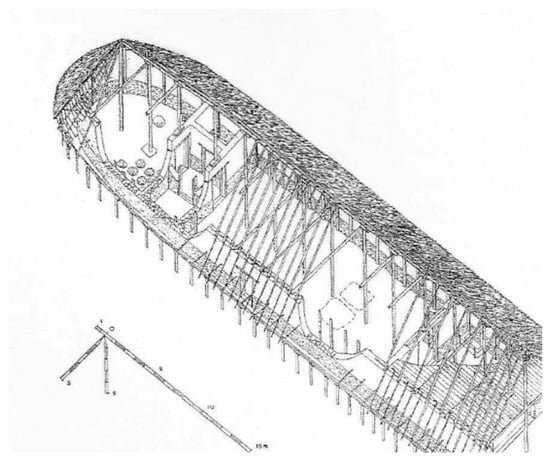
Figure 5.
Lefkanti—Toumpa, Evia, arched building.
During the Classical period, the use of adobe bricks was found not only in houses, but also in important public edifices, such as temples and fortifications like those of Athens, Mantineia, Eretria, Elefsina, and others [9]. In the archaeological site of the Alieis (located north of the citadel within the bay of today’s Portocheli), we can see representative examples of adobe houses of the Classical era (600–300 B.C.) (Figure 6) [10]. Building with adobe bricks has adapted to the evolution of architectural rectangular planes that were far more complex typologically and has as a main characteristic the inner courtyard. We could argue that earth contributed to a certain degree to the formation of that new architecture. The use of earth in Greek architecture continued mainly in the popular architecture in the following historical periods: Hellenistic, Roman, Byzantine, and Ottoman.
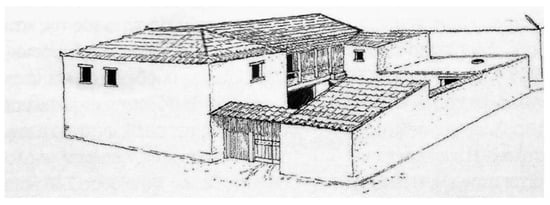
Figure 6.
Alieis, Portocheli, House 7, representation [10].
3.2. Technical Description of Traditional Techniques with Earth in Greece
Earth has been used either as a primary material in load-bearing walls in the form of adobe bricks or as a filling material in non-load bearing structures. It has also been extensively used in binding mortars and coatings. The oldest known methods of construction are those of combining raw wood (branches) with earth filling. Such buildings of mainly mixed use in rural settlements could still be found until the beginning of the last century in the Thessalian plain [11].
During the Minoan era, the construction with adobe as a building technique clearly appears, usually combined with stonework up to a certain height. This method was disseminated, developed, and adapted to the place, the historical context, and the general conditions (Figure 7).
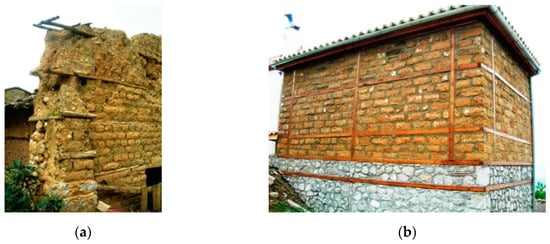
Figure 7.
Chrissi, Amfissa: (a) Row brick walls reinforced by timber tie beams that run alongside their width; (b) Renovated row brick walls (photos by A. Mousourakis).
In lowland areas where stone is scarce, such as the Thessalian plain or the Mantine plain in the Peloponnese, there can be found purely adobe brick structures with just a law stone foundation. In semi-mountainous areas, the percentage of stonework increases, and the use of adobe is usually limited to the upper floor or even in small parts of the bearing structure, as is the case in the Prespa lakeside settlements [12]. Often, but not always, the adobe brick structure is reinforced with horizontal wooden beams that run along the width of the walls at a certain height, ensuring that they are more effectively connected among themselves, usually repeating every 1 m height (also called xilodesies) (Figure 7). Almost always, these buildings are covered with tiled pitched roofs (with 1, 2, 3, or 4 slopes). Regarding the most recent applications of this method, there can be found a combination of adobe with reinforced concrete elements. The organization of building with adobe bricks was based on and required the involvement of the population of the local community; it had clear rules such as the specialization of craftsmen, participation of the users and their neighbors, specific work scheduling, financial organization of the pre-construction and construction phase, specific organization of preparation and transportation of the adobe bricks, and application of traditional technical building rules. One could say that building with adobe bricks had a significant cultural dimension, which unfortunately has been lost in our current world.
The combination of a bearing structure from treated timber with adobe or earth with straw (and stones or sawdust in other cases) is often encountered in the Greek traditional settlements. It is the technique of the so called “tsatmas” (wattle and daub building method), a system of timber frame wall filled in with adobe or mud (see Figure 8).

Figure 8.
Veroia: (a) Timber-framed traditional house; (b) Construction details of the exterior wall (photos by A. Mousourakis).
Lighter interior or exterior walls with a load-bearing timber structure and lined with small sections of wood or reeds, without filling, and a final coating of earth or lime plaster are the bagdati, found throughout virtually traditional architecture in Greece. Due to their light weight, these walls are often constructed on the upper floors of the ground floor and can protrude from the outline of the ground floor in the form of a sachnis, but also as simple exterior walls (Figure 9).

Figure 9.
Veroia: (a) “Bagdati” used in sachnisi and exterior walls; (b) Sides “Bagdati” exterior walls (photos by A. Mousourakis).
It could be argued that the combination of stone and adobe masonry and a timbered frame (tsatmas or bagdati) to a greater or lesser degree is the dominant traditional technique in Greece. However, also important are the applications of earth in secondary techniques such as earth floors, roofs with special clay, and compressed clay commonly found in island Greece such as Crete and other Aegean islands, the application of connective mortars in stonework and earth reinforced with plant and animal fibre such as straw, seaweed, and goat’s wool, or even with improved waterproofing properties with various additives such as cows’ dung, lime, etc.
3.3. Techniques and Dimensional Information
Earthen constructions are traditional housing solutions, because soils rich in clay are abundant and inexpensive. Only some of the earthen construction techniques were found in Greece. Earthen buildings follow the traditional standards of their period of construction, although they are also gradually being enriched with neoclassical elements, mainly in urban areas. A combination of stone and adobe masonry and a timbered frame (tsatmas or bagdati) is the most used technique; additionally, timber with adobe or earth with straw (and stones or sawdust in other cases) were found, as analyzed in the previous paragraph.
Adobe bricks: Evidence shows that they are the most common construction technique. Adobe bricks are air-dried brick, made of a mixture of loam, mud, sand, and water with binding additives as straw and formed in wooden molds. They can be made from most types of sub-soil. Enough clay is required for a strong result. The adobe is a structural element solid brick. The blocks are used for masonry and were bonded with mud and mortar and sometimes rendered with mud or plasters. They are simple to make and therefore appropriate for unskilled labor. They can be produced all at once or in small batches, as and when time permits. Different dimensions of adobe bricks were found in Greece, starting from Seklo 0.35–0.36 × 0.28 × 0.075 m3, Seklo tomb 0.45–0.47 × 0.30–0.31 × 0.08–0.085 m3, Minoan, Megaron Nirou Hani Crete 0.50 × 0.35 × 0.10-0.12 m3, Knossos 0.45 × 0.45 × 0.12 m3, Gournia Crete 0.48 × 0.36 × 0.097 m3, Mycenaean, Troy 0.65 × 0.10–0.15 × 0.85 m3, Iolkos 0.525 × 0.525 × 0.085 m3, Dimitriada (walls) 0.50 × 0.33 × 0.10 m3, Classic Corinth (wall) 0.45 × 0.45 × 0.09 m3, Elefsina (wall) 0.45 × 0.45 × 0.10 m3, Olinto 0.49 × 0.49 × 0.09 m3, and Modern, Karditsa 1915, 0.33 × 0.14 × 0.10 m3 [13].
Wooden frame walls (wattle and daub) are a technique made with a lattice of vertical studs and horizontal wattles, woven together like a basket. A mud of earth and straw is then daubed onto latticework, forced into the gaps, and smoothed over to fill any gap. The final surface can be left as a rustic finish or rendered with earth to make a smoother surface. A wooden frame more rarely is made of flexible tree branches. The surfaces of the buildings already studied were coated with mud and enriched with straw or hair, hay, or other fibrous materials for reinforcement and for better adhesion to the substrate. The thickness of the wall can range from 0.15 to 0.20 cm, so this makes the technique ideal for dividing interior spaces. When the construction is reinforced with diagonal elements and properly connected with the other building elements, it gives rise to earthquake resistance [14].
This technique also called “bagdati”, and in comparison to adobe it is much lighter and mainly used as partition walls and light external walls. Walls can be very thin, but they require lots of straight flexible sticks. Additionally, they offer poor insulation and low thermal mass unless thick plaster is added to increase mass.
4. Finding and Analysis of Architecture with Earth in Greece
4.1. Location, Uses, Historical References
The geographical distribution of earth buildings is scattered throughout the lowland and mainly rural, semi-urban, and urban areas of the mainland of Greece, although much has been lost in recent years. In these areas, there can be found simple single-story ground floor buildings as well as two-story and three-story imposing edifices of various uses such as residential, auxiliary and mixed-use, industrial complexes, churches, museums, shops, and so on (Figure 10).
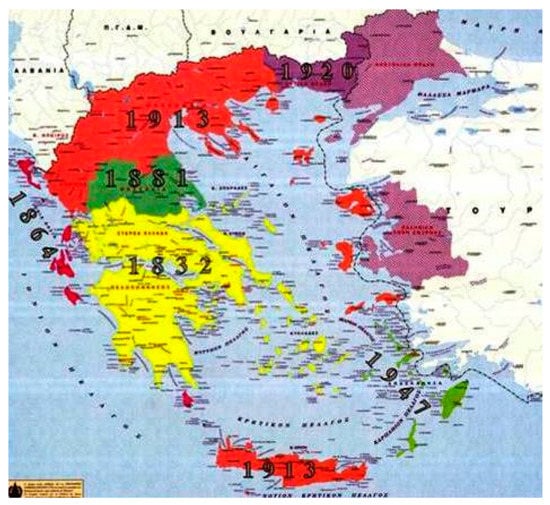
Figure 10.
Historical map of Greece (source: Hellenic Parliament).
4.2. First Greece
The Regions of Peloponnese and Central Greece are the areas that formed the first Greek state in 1830 after the liberation from the Ottomans. The long war of liberation was devastating, and its end left Greece with a large housing shortage. Most traditional buildings of the previous period were either completely destroyed or ruins that had to be pulled down by the government [15]. The need of the new state entity to express its identity by means of a new architectural style led to the adoption of neoclassicism, first in the urban centres [15], and then slowly but steadily this also affected the architecture of the smaller urban complexes (see Figure 11).
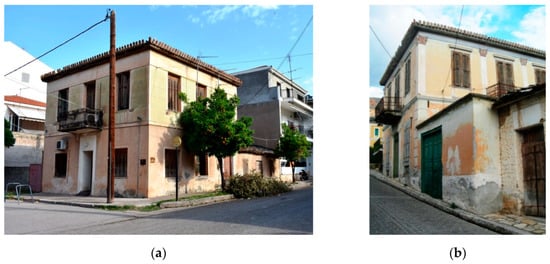
Figure 11.
Itea, Crissi: (a) Two floor urban building; (b) Adobe neoclassical houses (photos by A. Mousourakis).
Traditional building with adobe bricks, mainly in the lowland where earth was abundant, adapted to the new standards and was systematically implemented until at least the middle of the last century. Today, in many areas of the Peloponnese and Central Greece, several adobe buildings of various uses mainly built after the end of the 19th century can still be found. These buildings are located in rural (Figure 12) and semi-urban areas, but also in urban areas (see Figure 11, Figure 12, Figure 13 and Figure 14).
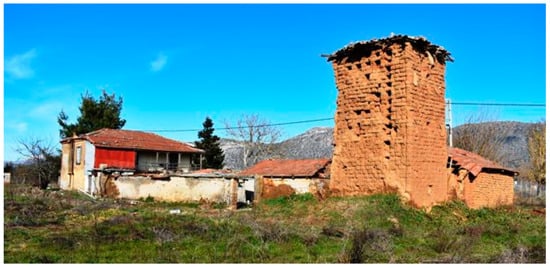
Figure 12.
Vassileios, Arcadia: Rural complex with a pigeon’s house (photo by A. Mousourakis).
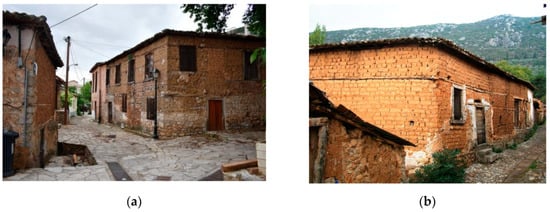
Figure 13.
Amfissa, Charmena: (a) Adobe building with timber frame structural details; (b) Small industrial buildings (photos by A. Mousourakis).
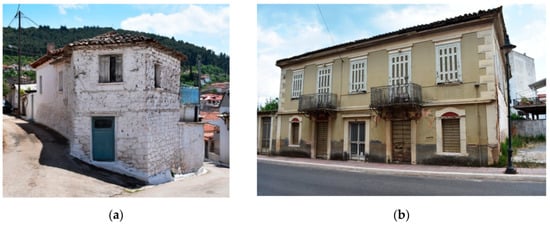
Figure 14.
Desfina, Messini: (a) Adobe houses; (b) Adobe houses with neoclassical architecture elements (photos by A. Mousourakis).
Although there are no accurate data to date, the areas that we have empirically identified in southern Greece with a significant earth architecture presence are (A) Peloponnese: North coast of the Peloponnese, Northeast Peloponnese from Corinth to Argos, the plain around Tripoli, the plain from the city of Messina to Meligala, the city of Sparta, the north-western coast Zaharo, up to Patras, and (B) Central Greece: the coast to the Corinthian Gulf with important historical cities and settlements such as Galaxidi, Amphissa, Itea, Chrisos next to Delphi, and urban centres in Eastern Central Greece such as Desfina, Livados, Thebes, Attica, and the capital of Greece, Athens.
4.3. Central Greece
Thessaly is the region that constitutes the central part of Greece. It was annexed to the newly established Greek state in 1881. The main characteristic of the area is the extensive Thessalian plain, where earth has been by far the mostly used building material [11]. Today, although building with earth is no longer practiced; a significant architectural supply from this material still survives and can be found spread throughout the plain (Figure 15).
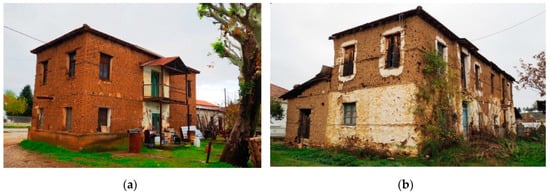
Figure 15.
Thessalian plain: (a) Two-floor building without plaster; (b) Two-floor adobe house with ground floor addition (photos by A. Mousourakis).
Inside or outside the rural settlements can be found single ground-floor or two-story buildings, mainly used for housing (Figure 16) and rural activities (Figure 17).

Figure 16.
Thessalian plain: (a) Two-floor building with terrace in columns; (b) Ground-floor adobe house (photos by A. Mousourakis).
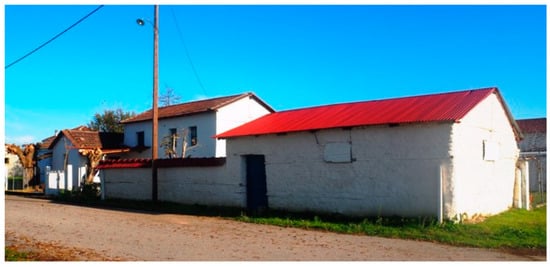
Figure 17.
Thessalian plain: adobe brick rural complex (photo by A. Mousourakis).
Furthermore, in the large urban centers such as Karditsa, Trikkala, and Tyrnavos, there are enclosures or isolated adobe buildings, usually abandoned. A rather small number of earth buildings have been listed in order to be protected and preserved. Unfortunately, at the same time, many important buildings have been demolished recently.
We could therefore distinguish the existing earth buildings into two categories: Those built in the Ottoman period, and those built in the post-liberation Greek period. Typical examples of the first period are the Kalakala’s mansion in Tyrnavos (Figure 18a), the Gerolimatos mansion in Larissa, and the Gerontopoulos mansion in Karditsa (Figure 18b).
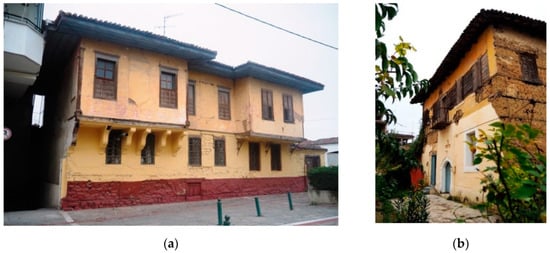
Figure 18.
Traditional adobe houses: (a) Tyrnavos, Kalakala’s house; (b) Karditsa, Gerontopoulos’ house (photos by A. Mousourakis).
These are mixed-structure buildings, with adobe brickwork on the ground floor and a timber frame structure filled with adobe bricks in the upper floor. As far as their typology is concerned, these buildings follow the traditional standards of their period of construction, although they are also gradually being enriched with neoclassical elements. The newer earth buildings are characterized by neoclassical and/or neoclassical-like architectural elements, and they can be either one- (Figure 19a) or two-story buildings, such as Rizopoulou’s house (Figure 19b) in Larissa [16].
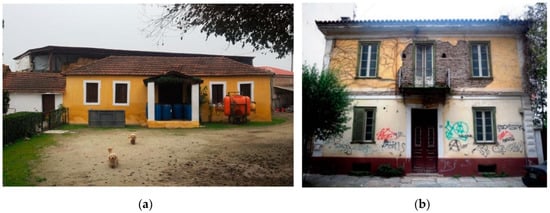
Figure 19.
Thessalian plain: (a) Adobe house ground-floor building with shelter at the entrance; (b) Larissa, Rizopoulos’ House (photos by A. Mousourakis).
Of particular architectural interest are the agricultural buildings found scattered throughout the plain of Thessaly (Figure 20a,b), either isolated or in groups.

Figure 20.
Thessalian plain: (a) Adobe house with wooden reinforcements; (b) Adobe rural complex (photos by A. Mousourakis).
These are relatively large adobe brick-built structures, often uncoated, with pitched roofs, usually oriented to the south, which have agricultural or mixed use. Their flexible floor plan has often helped the change of their original use.
4.4. Northern Greece
In this region, the districts of Epirus and Macedonia were annexed to the Greek state in 1913, 80 years after its establishment, and the Thrace district in 1920, and 88 years later. A significant stock of traditional architecture from the Ottoman period has been preserved and still exists, mainly in urban historical centers but also in smaller settlements. The use of earth with using the techniques previously mentioned is common, mainly in areas where the morphology of the soil favors its collection and processing. In Epirus, stone is the most prominent building material with very few exceptions (Figure 21). However, in Macedonia and Thrace, earth is a material very often used in traditional architecture. Generally speaking, the traditional architectural patterns of these areas are similar to those of the Southern Balkan countries such as Bulgaria, Northern Macedonia, Albania, and Turkey. Of course, in these areas as well, we find a significant stock of neoclassical architecture of the last century. Sub-areas with special features in their architecture can be identified.
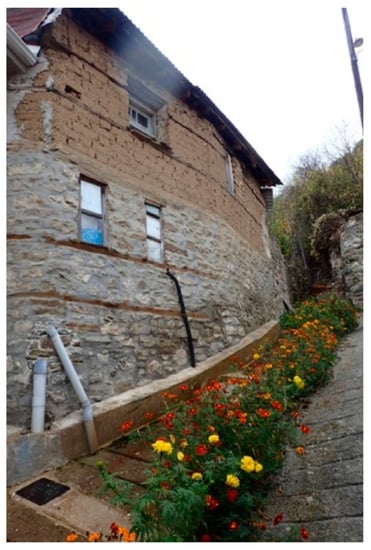
Figure 21.
Drosopigi, Konitsa, Epirus: House with adobe walls in the upper floor (photo by T. Mikrou).
4.4.1. The Region of Western Macedonia.
In this area, which includes the Prefectures of Kozani, Florina, Kastoria, and Grevena, can be found perhaps the most important earthen architectural heritage reserve in Greece. In the city of Florina, there are still a significant number of adobe brick-built mansions with neoclassical decorative elements and characteristic pediments [17]. Similarly, a large number of traditional timber-framed buildings of the 18th and 19th century are preserved in Kastoria. However, a very special case constitutes the existence of several smaller settlements on the borders of the two Prefectures of Florina and Kastoria, namely, the areas of Corestia and Prespa.
In the lakeside settlements of Prespa can be found an architecture that is based on different combinations of construction methods as a result of the variety of building materials that nature has to offer. The earth is used to make (a) adobe brick walls, (b) earth binding mortars for brick and stone walls, and (c) coatings. Other materials to be used are local stone, timber, and reeds (Figure 22a,b).
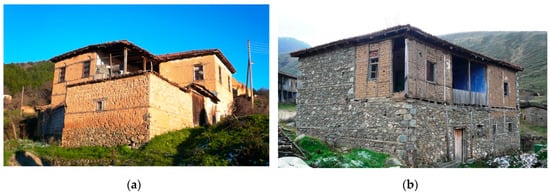
Figure 22.
Earthen architecture in Florina: (a) Antartiko, adobe brick house (photo by G. Chrisafaki); (b) Agios Germanos, raw brick house (photo by G. Chrisafaki).
As far as the construction is concerned, what is most interesting in the Prespa area are the different combinations of the above-mentioned building materials available that result in a large variety of structural systems. The local limestone is always used for the construction of the foundations or the relatively few underground spaces. Occasionally, it is also used for the ground floor or even the upper floor. However, in the vast majority of the buildings, the system of perimeter load bearing adobe walls, with a thickness of more than 50 cm (Figure 23), is adopted.
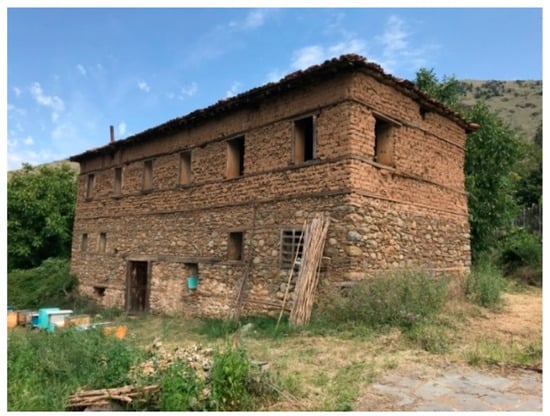
Figure 23.
Agios Germanos, Florina: Adobe brick house (photo by S. Kotsopoulos).
The interior load bearing structure most of the time is made of timber-framed structures filled with adobe bricks (the tsatma–catma type). In any case, the binding material consists of earth and small admixtures, such as little stones, haystacks, sheep and goat hair, etc. Regarding the coatings, the second and final layer is more refined, often without any admixtures. Of particular interest is the creation of horizontal surfaces intended for the thermal insulation of the interior spaces. Here as well, a variety of structural solutions are encountered, the most common being the use of reed roofs. In this case, the layers created by the well fit next to one another and reeds are suspended from the wooden beams of the roof and coated with a thick layer of clay, thereby acquiring increased thermal insulation properties, necessary for the extreme cold conditions characterizing the area.
In the neighboring area of Korestia, numerous settlements were developed, the buildings of which are almost entirely constructed of load-bearing brickwork (Figure 24a,b and Figure 25). The variety of soil types, which can vary even in neighboring areas, yields an impressive range of ochre and red shades. It should be noted, however, that in the original state of the buildings, except perhaps for some temporary auxiliary constructions, the masonry had to be externally coated for protection against moisture (Figure 26).

Figure 24.
Kranionas, Florina: (a) Adobe house (photo by G. Chrisafaki); (b) Adobe house, with “bagdati” wattle και daub, on the first floor.
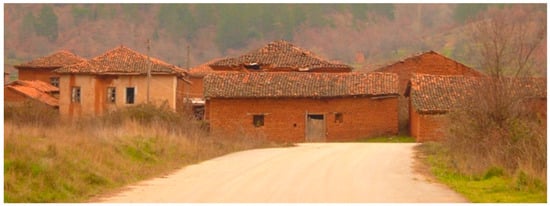
Figure 25.
Kranionas, Florina: adobe houses (photo by G. Chrisafaki).
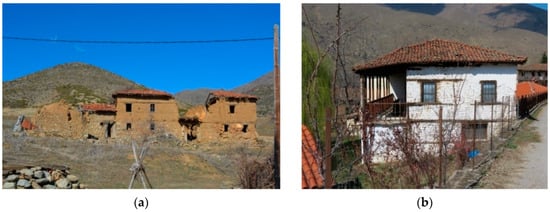
Figure 26.
Prespes, traditional architecture: (a) Laimos, Florina: adobe houses (photo by S. Kotsopoulos); (b) Agios Germanos: adobe houses (photo by M. Arakadaki).
The inaccessibility of the area, the delayed appearance of tourism, the mild development, and the designation of the Prespa area as a National Park helped the preservation of the architectural heritage and the natural environment of the two areas. In addition, the almost complete desolation of the majority of these settlements in recent decades has contributed to the preservation of many buildings in their original typology and form, despite the partial damage and collapse caused by time, abandonment, and the perishable nature of the material itself (Figure 23).
4.4.2. The Historical Centers of the Towns of Macedonia
In many historical city centers in Macedonia, such as Kastoria, Veroia, Eleftheroupoli, and Kozani, earth has been used as filling material in timber-framed load bearing walls of the upper floor (sachnissi) or in the plasters of these buildings in a typical, traditional way.
4.4.3. The Mount Athos
Although the main building material in monasteries and other buildings on Mount Athos is stone, earth is used in applications that are based on earth, like the ones that have already been described (Figure 27a).

Figure 27.
Earthen architecture in timber frame structures: (a) Mount Athos: detail from a timber-framed exterior wall; (b) Xanthi: traditional house with sachnissi.
4.5. Thrace
The region of Thrace was the last to be incorporated in the Greek state (1922) and thus retains many of its traditional features. Thrace is a multicultural area that includes the prefectures of Xanthi, Rodopi, and Evros and holds a very important reserve of architectural heritage of stone and timbered structures dating from the 19th to the mid-20th century. As a result of the rich stone reserves in the wider area and in combination with the experience and craftsmanship in the elaboration and use of stone by the artisans of the time, the buildings preserved in Thrace consist mainly of load-bearing stone masonry in the perimeter of the building on the ground level and light, timber-framed walls beams on the upper floor. However, earth, as a natural building material, is used in most of these structures [18], either as a bonding mortar of the masonry or for the coating of their inner and outer surfaces (Figure 27b, Figure 28a,b). This particular use of earth is most often found in the buildings of the lowland and semi-mountainous rural settlements, as well as in the 19th-century constructions preserved in the urban centers of the area (Xanthi, Komotini).
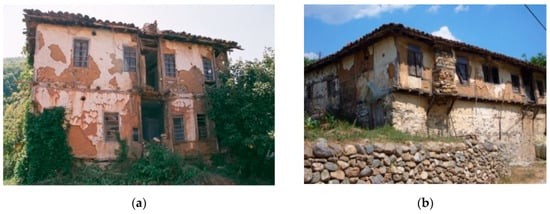
Figure 28.
Medousa, Xanthi: (a) Two-story building with damage at the timber elements; (b) Τwo-story building with reinforcement with timber elements (photos by I. Sinamidis).
Of particular interest is the construction of the light load-bearing walls made of plait, a timber frame in which horizontal elements of wattle are knit together. This is mainly used in the Pomak settlements of the Rhodope Mountains (Medusa, Kotyli, and Echino). This structure is then coated with a thick layer of clay, both inside and out (Figure 29a,b). Rarely, in the same settlements, adobe bricks are also used, usually on small surfaces, in the upper part of the exterior walls or in later phases of construction (Oreo, Akreo) (Figure 30a,b).
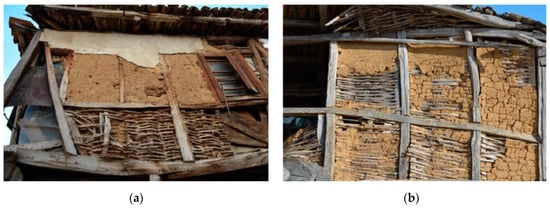
Figure 29.
Prefecture of Xanthi: (a) Cotuli: House (photo by I. Sinamidis); (b) Echinos: House (photo by I. Sinamidis).

Figure 30.
Prefecture of Xanthi: (a) Akreo: House (photo by I. Sinamidis); (b) Oreo: House (photo by I. Sinamidis).
Extensive use of adobe bricks was made in the area during the period 1930–1950, with the refugee establishment and the creation of new settlements, mainly in the prefecture of Rodopi (Aigiros, Thrillorio, Kallithea, etc.). A significant number of dwellings, mainly single-story ones, are entirely built of load-bearing adobe brickwork. At the same time, the use of adobe brick as a building material is also found in the lowland Muslim settlements of the prefecture, mainly in auxiliary buildings (Isalos, Fylakas, etc.).
In the same period, the construction of a flour mill in the settlement Aigeiros of the prefecture of Rodopi included load-bearing walls made entirely out of adobe brickwork (Figure 31a,b). Today, in the perimeter walls parts of stone masonry and baked bricks can be found, but these were constructed at a later time and in order to replace crumbling or damaged adobe bricks.
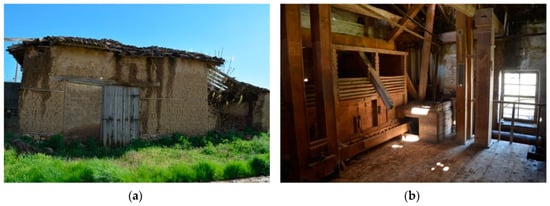
Figure 31.
Aigeiros, Rodopi, flourmill: (a) exterior, main entrance; (b) interior (photos by I. Sinamidis).
4.6. The Islands
With the exception of Crete and Euboea, where it is well known that the construction with adobe bricks or using the timber-frame technique existed since the prehistoric times and until the middle of last century [19], there is not a clear idea of the extent of such applications in the rest of the Greek islands. A particular category of buildings that could perhaps be mentioned in this research are the Santorini rock-hewn or “cave” buildings. Such spaces derived from the removal of material from the rock and the housing and storage were created (Figure 32).
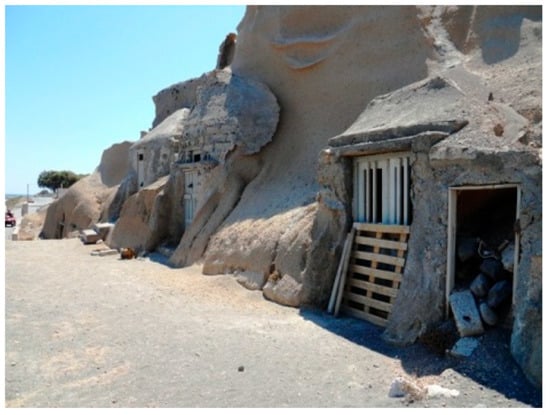
Figure 32.
Santorini: troglodyte cave-like houses (photo by Ch. Triantafyllou).
4.7. Classification of the Different Techniques Existing
In this research, several buildings’ uses were found. Most of the constructions are settlements and some of them are industrial buildings, agricultural buildings, warehouses, and other buildings. The earth is used to make (a) adobe brick walls, (b) earth-binding mortars for brick and stone walls, and (c) coatings. Other materials to be used are local stone, timber, and reeds. As it is presented in drawing of Figure 33, Figure 34, Figure 35 and Figure 36, combinations of local materials and earth were used. The adobe walls are around 50 cm, and a wooden frame roof is usually covering the building. The following drawings, from different regions of Greece, give an idea of the scale of earthworks.
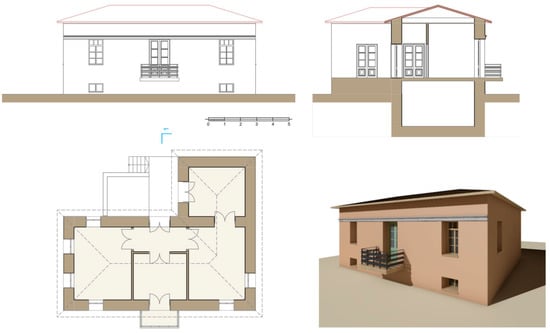
Figure 33.
One-story house with basement in Lehaio, Korninthia, 37°56′12.4″ N 22°50′23.4″ E, plastered façade (drawings by T. Mikrou).
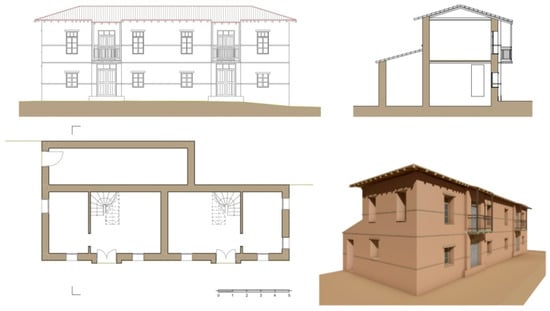
Figure 34.
Two-story twin houses with a barn at Magoulitsa, Karditsa, 39°26′12″ N 21°45′41.2″ E (drawings by T. Mikrou) [20].
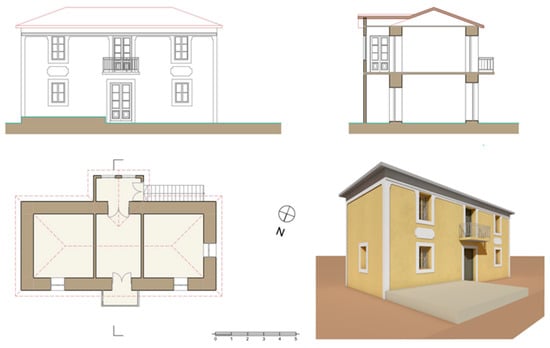
Figure 35.
Two-story house in Solomos, Korinthos, 37°52′39.2″ N 22°53′23.5″ E. Plastered facade adorned with neoclassical elements (drawings by T. Mikrou).
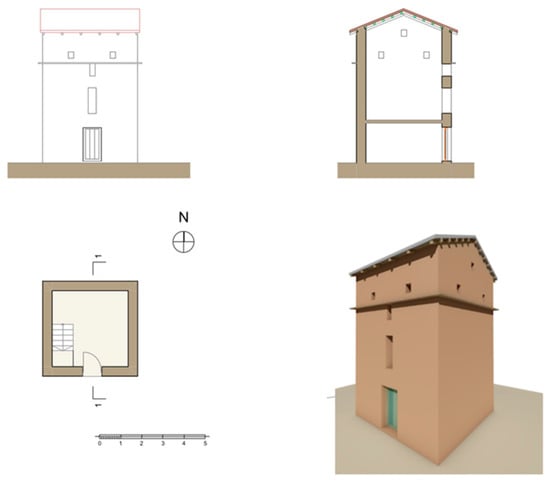
Figure 36.
Pigeon house, Pelagos, Arcadia, 37°31′24.6″ N 22°25′11.1″ E (drawings by T. Mikrou).
5. Finding and Analysis of Architecture with Earth and Other NATURAL materials in Greece in Recent Years
5.1. Architecture in the Emergency Years 1910–1925
Since 1910, and with a dramatic surge in the years 1922 to 1924/25, refugee waves flooded Greece with five million inhabitants, increasing the country’s population by 1.5 million, mainly women and children. The urgent need for permanent housing, especially during the early stages of migration, where the scarcity of resources and especially building materials was enormous, was largely covered by simple earth-based construction techniques. Usually these techniques were performed by the method of self-manufacture with in-situ materials. The main construction technique was based on load-bearing adobe brick masonry and more rarely on timber structures [21,22] (Figure 37a,b). Earth buildings and settlements of that time are still found today in the refugee’s first settlement areas.
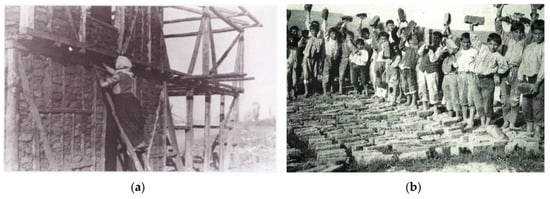
Figure 37.
Adobe constructions in the early twentieth century: (a) Refugees’ timber-framed self-structure (Megalooikononomou archives); (b) Construction of raw bricks by refugee kids (NGM, Tmavridis archives).
The majority of the refugees who settled in cities like Athens were first placed in shantytowns in suburbs of the city. The new settlements were built after 1923 and were made of earth or more seldom with stones (Figure 38).
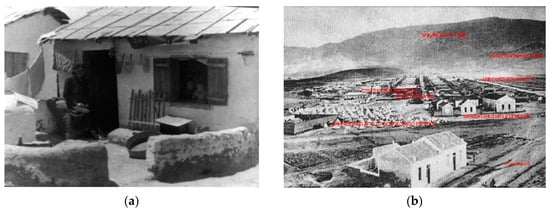
Figure 38.
Kaisariani, Athens: (a) Adobe houses; (b) Panoramic view of Kaisariani, the tents near the Syggrou Hospital, and the new constructions in the right side, October 1924, KEMIPO archive [23].
5.1.1. Nea Ionia
Nea Ionia (meaning New Ionia) is a northern suburb of Athens. It was habited by refugees who migrated in the 1920s from the region Anatolia and other cities of Asia Minor because of the population exchange between Greece and Turkey in 1923 (Figure 39). The arrival of so many people in so short a period of time imposed significant costs on the Greek economy, such as building housing and schools, importing enough food, providing health care, etc. The first time, the camp was created with tents. The next step was to create shelters from readily available resources in order to create a built environment.
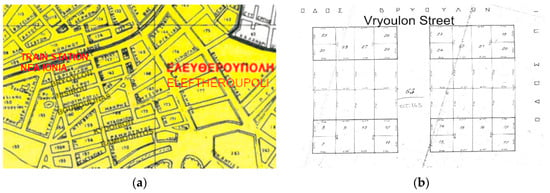
Figure 39.
Nea Ionia, Athens: (a) urban plan; (b) building blocks of Nea Ionia (source: Municipality of Nea Ionia).
The urban residential patterns of settlements have been based on orthocanonical plans. The module, which was repeated, consisted of a one-room house around 20 m2 for a small family and a bigger one, around 35 m2, for bigger families. An often-designed pattern consisted of sixteen small and eight bigger houses. Some of the houses were semi-detached, built as pairs in which each house’s layout is a mirror or exactly-repeated plan and façade. One room, around 20 m2, was given for every family, and in most cases, the relatives of the family lived in adjoining rooms. The rectangular design of each block had dimensions close to 30 × 18.5 m2. Every settlement had one door and one window in the front façade. A door on the back wall connected the room with the common space in the middle of the block. The following photos are from the Eleftheroupoli neighborhood in Nea Ionia (see Figure 40, Figure 41, Figure 42, Figure 43, Figure 44, Figure 45 and Figure 46).
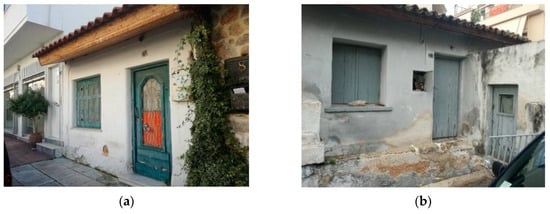
Figure 40.
Eleftheroupoli, Nea Ionia, Athens: (a) Vryoulon street 10, a renovated building that has been given the sidewalk fpr public use; (b) Vryoulon street, a building with an extension to the street boundary (photo by E. Frangedaki).
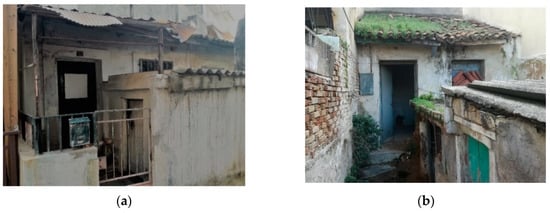
Figure 41.
Eleftheroupoli, Nea Ionia, Athens: (a) Mpoympoulinas 30, addition of a room that reduces the window by half; (b) the entrance and later additions of a house in the middle of the building block, a pedestrian street parallel to Mpoympoulinas street (photo by E. Frangedaki).
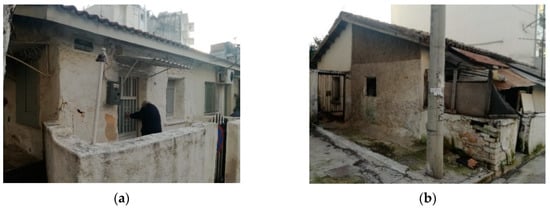
Figure 42.
Eleftheroupoli, Nea Ionia, Athens: (a) Mpoympoulinas 34, the courtyard is formed up to the border of the road with a wide fence; (b) Mpoympoulinas 10, two different properties under the same gable roof (photo by E. Frangedaki).
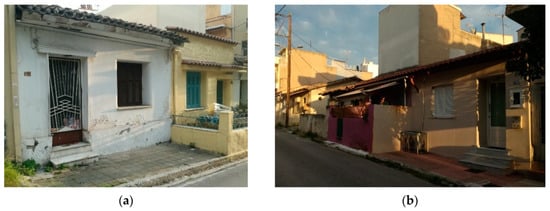
Figure 43.
Eleftheroupoli, Nea Ionia, Athens: (a) Nymfeou 48, subsequent addition of a metal door; (b) Nymfeou 10, buildings that were extended with different uses until the street’s boundary (photo by E. Frangedaki).
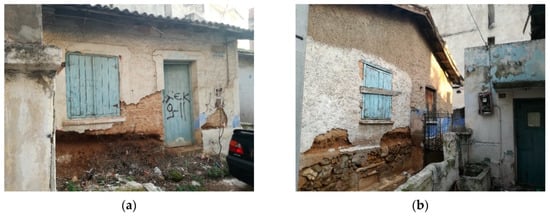
Figure 44.
Nea Ionia, Athens, House in Kydonion street: (a) front view with one window and one main entrance; (b) side façade with the entrance to the back half property (photo by E. Frangedaki).
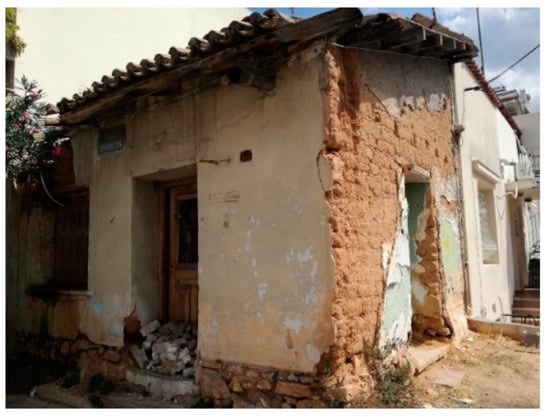
Figure 45.
Nea Ionia, Athens, Kydonion, and Rodou Street, a half of the building. The second room was demolished. Τhese are the signs of the positions from the timber framed ceiling (photo by E. Frangedaki).

Figure 46.
Nea Ionia, Athens, House in Kydonion street: (a) The plastered interior of the house; (b) Detail of the wooden frame of the window (photo by E. Frangedaki).
Every two houses had a common sloped roof. The two different properties shared a gable roof. Each property ended at the ridge of the roof. The apex line of a sloping roof was designed to be perpendicular or in parallel to the street axis. The rafters were wooden and were extending from ridge to eves. The family of every block had to share a common space in the middle of the block for the water closet. The need for more space had lead to several extensions, with no development rules, but as we can conclude from the existing houses, a defined guideline for side and rear extensions existed. Front extensions were usually allowed, except in the case where the house ended on the street, and there was not substantial distance for a new construction. The front extensions included a small room, between one to two meters wide and up to the street border. The width of the room was limited so as not to obstruct the unique window of the facade of each house. The height of this addition was lower than the low point of the sloped roof of the original building and usually had a flat roof. The rest of the outdoor space is often used for cooking or for rest. The floor of the outdoor space was higher than the road, but has varied widely depending on the changes of the street level through the years.
5.1.2. Kaisaraini
Kaisariani is an urban area and belongs to the Municipality of Athens, located three kilometers east of its center along the lower slopes of Mt. Hymettos. Kaisariani was first inhabited by refugees who came to Greece after the Asia Minor war in 1922; until then, most of the land was a pasture. Most of the refugees who inhabited there came from Smyrna and surrounding villages such as Vourla [24]. When Kaisariani joined the city plan in July 1923, it had an area of 231 acres. The first-arrived refugees began to be installed temporarily and partially in conical army tents near the Infectious Diseases Hospital of Syggrou (see Figure 47).
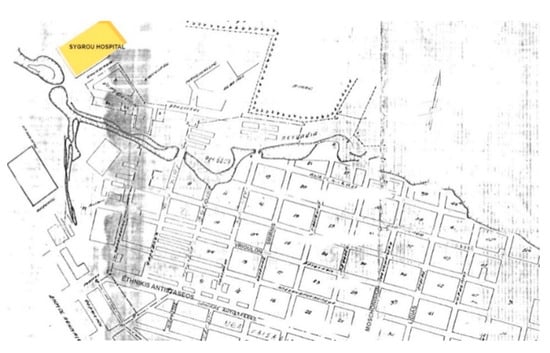
Figure 47.
Urban Plan of Kaisariani (source: Municipality of Kaisariani).
After the tents and the iron sheet shelters, the first adobe units were built with aid from the American Near-East Relief Charitable Organization on the lower slopes of Mt. Hymettos. These blocks of buildings consisted of several small houses with the same dimensions. Later, around the 1970s, a modern apartment was built on the footprint of adobe houses. In May 1923, the construction of 500 wooden shacks and 1000 adobe brick rooms began. For the planning of the construction squares, they were adapted as building blocks. They were narrow rectangular domestic residences, usually no more than about (3.5 m) wide, with one or two rooms, depending on the members of the family. Every 10 or 12 houses composed a square, an urban block. In the center of each block existed a kind of courtyard, where the common toilets existed [25]. The adobe construction technique was the main way of building houses for the refugees, as these earthen constructions were incomplete and could get individual interventions by the users. At first, the shortages were dramatic, and the projects were progressing slowly (see Figure 48, Figure 49, Figure 50, Figure 51 and Figure 52).
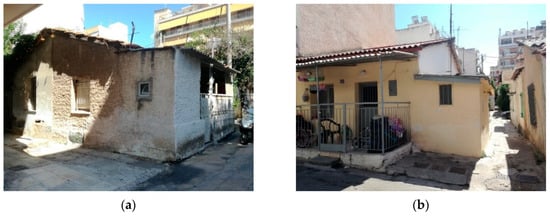
Figure 48.
Kaisariani, Athens: (a) Iroon Politexniou street, house with additional construction of a toilet in the width of the garden-lawn; (b) Manolidis street, with additional construction of a room in the width of the side street (photo by E. Frangedaki).
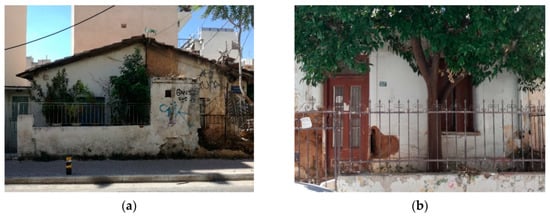
Figure 49.
Kaisariani, Athens: (a) Moschonision and Manolidis street, main view of a building with a gabled roof that includes two properties; (b) Ephesus street 48, adobe house with neoclassical–like architectural elements (photo by E. Frangedaki).
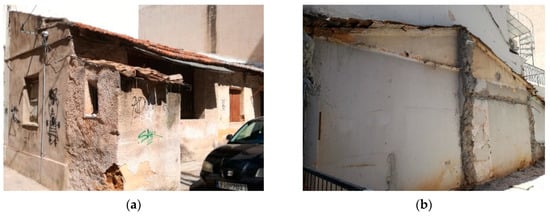
Figure 50.
Kaisariani, Athens (a) Vryoulon 59 street, renovated adobe house with one room left on the sidewalk; (b) Signs of the section that shows the two different settlements with a different ceiling height (photo by E. Frangedaki).
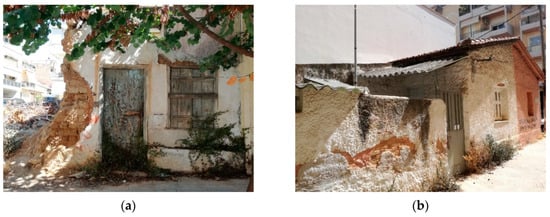
Figure 51.
Kaisariani, Athens: (a) Lydias & Vryoulon street, the half of the adobe house; (b) Vryoulon 87 street, adobe house and additional constructions (photo by E. Frangedaki).
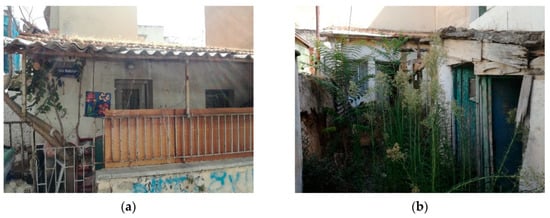
Figure 52.
Kaisariani, Athens: (a) Manolidi street, with later extension of the roof; (b) Pedestrian Street, perpendicular to Manolidi street, adobe house in the center of the building block (photo by E. Frangedaki).
6. Contemporary Tendencies in Architecture Using Natural Materials in Greece
After World War II, earth construction in Greece was abandoned, except for rare cases of mainly restoration of existing buildings. The most usual building defects and failures that occur in construction are climatic conditions like increased rainfall; location of the construction, especially when located near a river where water is moving from the ground, as penetration of moisture and increased humidity destroys bricks; unsuitable materials like a lack of proper clay in the soil and also the wrong proportion of materials in the mixture; or bad maintenance of the building, as building maintenance has a major role in preventing building defects. After the end of the last century, along with various bioclimatic and other ecological experiences, the first experimental, mainly small, constructions using traditional and modern earth construction techniques appeared. These applications are usually manufactured in laboratories by various colleges throughout Greece (Figure 53). The mobility of experts from around the world, the Internet, and the world-wide experience in physical construction have facilitated the dissemination of these techniques (see Figure 53).
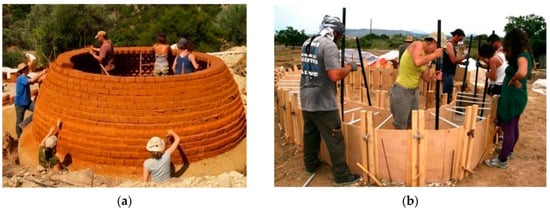
Figure 53.
Piliko team: (a) Adobe construction; (b) Experimental constructions based on rammed earth technique during workshops (photos from Piliko archive).
Shortly afterwards, the first new buildings with earth-based or other natural materials such as straw balls appeared. These experiences applied studies based on relevant national and European legislation. Apart from the traditional techniques already mentioned, the new techniques have mainly applied composite wooden carrier construction with light clay or straw bales. In smaller architectural interventions such as exterior landscaping, we meet the technique cob and rammed earth, and also on coatings and floors, we now come across various types of earth mortar and lime mortar.
7. Discussion
The earthen construction heritage of Greece has a great variety in the form and ways of using earth for local needs and space. Although these constructions have differences, most of them, mainly adobe constructions, are established in the inner plains (between mountains) of Greece, and the other techniques with less use of earth like bagdati and tsatmas can be found in mountainous areas. The possible areas with earthen architecture in Greece, according to G. Bei’s study, are limited. After the records in many areas of Greece, it is found that many more villages in the Peloponnese and also in Thessaly plains have an important earthen building culture. Subsequently, areas of Prespes in Macedonia, Thrace, and the islands have constructions based on earth. The residential architecture of Greece incorporates architectural European architectural elements eclectically mixed with traditional style. Therefore, adobe bricks, timber frame filled with adobe, wattle and daub to achieve greater height, and bagdati and tsatmas for larger openings are found, according to the architectural style adopted.
Additionally, this study and documentation of earthen constructions contributes to a record of both bad and good structural post-earthquake behavior, which can become very helpful for the identification of new provisions for earthen buildings conservation. After observing the local architecture developed to tackle earthquakes, as well as the pros and cons of existing building culture, it would be easier to predict the behavior of a building and undertake the adequate interventions to establish principles for earthen heritage conservation.
8. Conclusions
Earthen constructions present architectural diversity and shape a part of the nation’s culture; they are a vital part of Greece’s heritage and require protection. From this study that has been conducted on the earthen architecture in Greece, it can be concluded that an important percentage of earthen construction in rural and urban areas still exists. Earthen constructions are found since ancient Greece, and they still remain, even without preservation, from the Ottoman period. In the urban areas, the earthen housing for refugees from the Asia Minor Catastrophe in the 20th century is an integral part of Greek history due to the demographic, economic, and social change; many paradigms of earthen architecture of this period still exist. The most popular earthen techniques found are adobe and wattle and battle. In every region, the binding materials, like straw, wool, animal hair, and other renewable materials vary, and they are related to local products. Buildings are one or more stories, with a timber framed roof, usually covered with tiles.
The intensive research of the use of earth in Greek architecture can significantly affect three major themes:
Firstly, archaeological research in the field of architecture, both in prehistoric and historical times: Careful study of earth applications in antiquity will help to better manage and read excavations. Secondly, traditional architecture, both in Greece and in the wider Balkan region: Recording, highlighting, and restoring our architectural heritage will reveal an important resource and contribute to future sustainable development. Thirdly, contemporary architectural design and construction, by improving the environmental behavior of our buildings and cities.
Understanding and implementing earthen architecture in buildings can contribute positively to cities that are healthier for humans and environmentally friendly. That means architecture that does not consume more resources than it produces, does not produce more waste than it can absorb, and is not toxic to itself or to other ecosystems; all these parameters are satisfied with earthen architecture, and the constructions we studied prove this argument. The study, documentation, and dissemination of existing structural post-earthquake behavior of buildings around Greece can make earthen architecture a useful tool for future safe, sustainable architecture. Finally, it is necessary to use tools, such as booklets, as well as educational campaigns carried out through popular organizations, local governments, and the media in order to disseminate earthen architecture and its importance for the maintenance of Greece heritage. Important issues of seismic design requirements should be discussed, and preservation or new constructions should be based on a new building code for load-bearing earthen structures.
Author Contributions
Conceptualization and data curation by A.M., M.A., S.K., I.S., T.M. and E.F.; writing—original draft by A.M., M.A., S.K., I.S., T.M. and E.F.; writing—review & editing by N.D.L. All authors have read and agreed to the published version of the manuscript.
Funding
This research received no external funding.
Conflicts of Interest
The authors declare no conflict of interest.
References
- Filippidis, D. Abelakia; Melissabooks: Athens, Greece, 2001. [Google Scholar]
- Oikonomou, A. Traditional Earthen Architecture in Northwestern Greece. In Proceedings of the 12th World Congress on Earthen Architecture, Lyon, France, 11–14 July 2016. [Google Scholar]
- Conti, G.; Di Chiacchio, A.; Cicchitti, M.; Fiadone, F.; Forlani, M.C.; Gentile, P.; Morandi, M. Terra cruda, Insediamenti in Provincia di Chieti; Provincia di Chieti: Penne, Italy, 2017. [Google Scholar]
- Perrotti, A.; Pisano, P.; Chicchitti, M.; Fiadone, F.; Gentile, P.; Vaccarini, G. Case in terra cruda, diffusione degli insediamenti in Abruzzo. Censimento, Regione Abbruzzo, Assessorato Urbanistica, Beni Ambientali, Parchi, Riserve Naturali; Cultura Gruppo Tipografico Editoriale: L’Aquila, Italy, 1999; Volume 1. [Google Scholar]
- Mousourakis, A.; Arakadaki, M.; Mikrou, T.; Tsakanika, E.; Mandalaki, M. Mapping the traditional earthen architecture in Greece. In Proceedings of the Construction Pathology, Rehabilitation Technology and Heritage Management Conference, Granada, Spain, 24–27 March 2020. [Google Scholar]
- Adrymi–Sismani, V. Prehistoric settlement of Sesklo, Prehistoric settlement of Dimini. Archaeol. Mag. 1990, 34, 21–30. [Google Scholar]
- Davaras, K. Γουρνιά, (Gournia); Ministry of Culture: Athens, Greece, 1989; p. 16.
- Mazarakis Ainian, A. Architecture and society in the early historical times. Archaeol. Mag. 2009, 112, 19–23. [Google Scholar]
- Fields, N. Ancient Greek Fortifications, 500–300 BC, Methods of Construction; Tessera Pi Publication: Athens, Greece, 2011; pp. 47–57. [Google Scholar]
- Bradley, A. The archaeology of residence at Alieís. Archaeol. Mag. 2009, 112, 47–57. [Google Scholar]
- Megas, G. Aγροτικαί πεδιναί οικήσεις (Rural Plain Settlements), Θεσσαλικαί οικίσεις (Thessalian Settlements); Ministry of Reconstruction: Athens, Greece, 1946; pp. 10–16.
- Karaderos, Y.; Tsolakis, P.; Prespes, T. Greek Traditional Architecture; Melissa Publishing House: Athens, Greece, 1990; pp. 161–198. [Google Scholar]
- Achenza, M.; Atzeni, C.; Mocci, S.; Sanna, U. Il Manuale Tematico della terra cruda: Caratteri, Tecnologie, Buone Pratiche; Dei-Tipografia del Genio Civile: Roma, Italy, 2008. [Google Scholar]
- Frangedaki, E. Optimizing engineering aspects of earth constructions. The earth as “common” material. In Proceedings of the European Geosciences Union General Assembly, Vienna, Austria, 7–12 April 2019; Volume 21. [Google Scholar]
- Economou, K. The Mansions of Central Greece, Urban and Popular Residence in the Greek Tradition; Ziti Publications: Thessaloniki, Greece, 2013; pp. 172–173. [Google Scholar]
- Panagou, V.; Kandila, I. Old Mansions and Remarkable Buildings of Larissa; Ant. Stamouli Publications: Athens, Greece, 2016. [Google Scholar]
- Economou, K. Florina and Its Region, Urban and Folk House in the Greek Tradition; Ziti Publications: Thessaloniki, Greece, 2013; pp. 288–316. [Google Scholar]
- Kizis, J. Thrace, Greek Traditional Architecture; Melissa Publishing House: Athens, Greece, 1990; Volume 8, p. 204. [Google Scholar]
- Kada, D.; Mandalaki, M.; Mousourakis, A. Buildings made of raw bricks in Crete: Lessons of building constructions through the recording and preservation of cultural heritage. In Proceedings of the 3rd Panhellenic Conference on Digitization of Cultural Heritage, Athens, Greece, 25–27 September 2019. [Google Scholar]
- Drawings Based on Measurements Made by the Students in the Framework of the Analysis of Traditional Settlements Course of the School of Architecture, NTUA. Available online: https://5a.arch.ntua.gr/project/15628/16086 (accessed on 1 October 2020).
- Morgenthau, H. My Mission in Athens; Trohalia Publications: Athens, Greece, 1994; p. 338. [Google Scholar]
- Mavrogeni Papagelopoulou, P. Dissertation, Social Stratification and Morphology of Two Neighboring Settlements of Psychiko and Nea Ionia from 1923 Onwards. Ph.D. Thesis, Panteion University of Social and Political Science, Athens, Greece, 1999. [Google Scholar]
- Archaeological Institute of America. Available online: https://archive.archaeology.org/diggreece/house7.html (accessed on 12 June 2020).
- Online Encyclopaedia on the Greeks in Asia Minor. Available online: http://asiaminor.ehw.gr/forms/fLemmaBodyExtended.aspx?lemmaID=5944 (accessed on 10 June 2020).
- Center of Study and Promotion of Asia Minor Culture. Available online: https://kemipo-neaionia.gr (accessed on 21 August 2020).
Publisher’s Note: MDPI stays neutral with regard to jurisdictional claims in published maps and institutional affiliations. |
© 2020 by the authors. Licensee MDPI, Basel, Switzerland. This article is an open access article distributed under the terms and conditions of the Creative Commons Attribution (CC BY) license (http://creativecommons.org/licenses/by/4.0/).